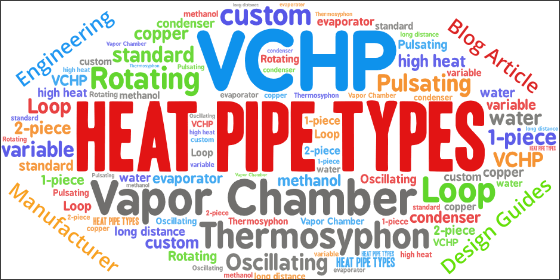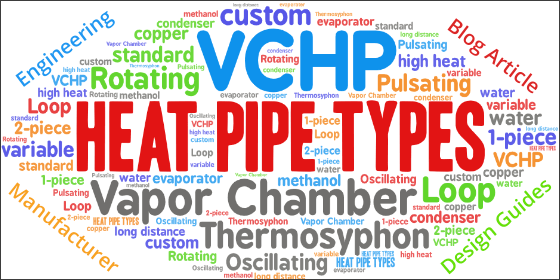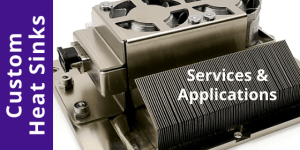This article explores the design and best uses of different types of heat pipes used for electronics cooling. These include:
- Standard Heat Pipes & Vapor Chambers
- Variable Conductance Heat Pipes (VCHP)
- Thermosyphon & Loop Thermosyphon
- Loop Heat Pipes
- Rotating Heat Pipes
- Oscillating / Pulsating Heat Pipes
Standard Heat Pipes | Vapor Chambers
Constant conductance heat pipes (standard or CCHP) and vapor chambers are by far the most prevalent type of heat pipe used for cooling electronics. As Celsia has numerous website pages on this subject (see below), we won’t do a deep dive here. However, we’ll use this definition of a standard heat pipe when comparing them to other types: a copper enclosure with a copper sintered wick structure attached to the entirety of the inner walls of the device and a small amount of water as the working fluid.

Standard Heat Pipe Inner Workings
As with many of the other types of heat pipes, standard heat pipes can be made of different envelope materials, use different wick structures, and have alternative working fluids. However, these subjects are beyond the scope of this article.
Vapor chambers are the first type of heat pipe variation. While it’s true that the most used vapor chambers closely mimic their heat pipe cousins (copper enclosure, sintered wick, water working fluid) they are designed to function as a planar heat spreading device and need a support structure to ensure adequate vapor flow and for structural integrity under clamping loads. Heat pipes can be flattened to a width-to-height aspect ratio on the order of 4:1 while vapor chambers achieve up to 60:1 aspect ratio. This design makes them a much better heat spreader and perfect for applications where a high degree of isothermality is required.
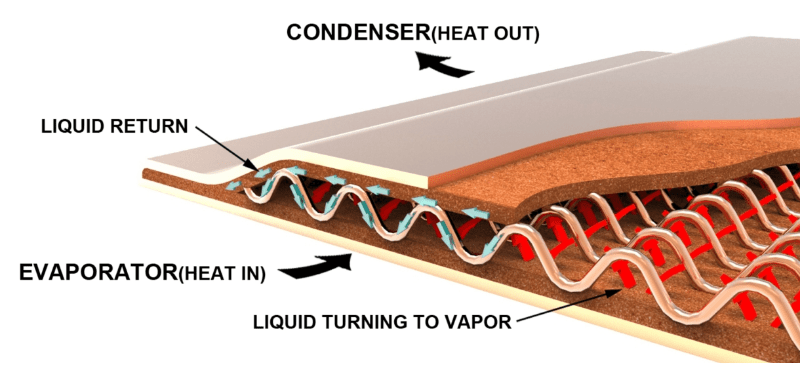
Vapor Chamber Working Principles
Variants on vapor chambers include 2-piece and 1-piece construction. The first uses a traditional manufacturing method where two stamped copper plates are bonded together, complete with wick structure, working fluid, and the addition of a support structure. A 1-piece design begins life as a very large tube (up to 70mm diameter), that’s sintered then flattened after a support structure is added. Benefits of this design include lower cost and the ability to be bent into ‘L’ and ‘U’ shapes. Here are some useful vapor chamber links:
All heat pipe variations discussed below share a few common characteristics: they use a working fluid that’s matched to the environmental operating conditions of the application, the enclosure of the ‘heat pipe’ can be made from a variety of materials but must be compatible with the working fluid, and the device is evacuated to form a vacuum allowing the working fluid to vaporize at temperatures below what would be required if at atmospheric pressure. In short, all variants are two-phase devices.
Variable Conductance Heat Pipes
In contrast to standard heat pipes or vapor chambers (constant conductance devices), variable conductance heat pipes (VCHP) minimize temperature swings at the evaporator, usually at the lower end of the operating temperature range. Based on the power input and/or changes to the ambient temperature the device uses a varying degree of the condenser fin area by limiting the vapor space inside the heat pipe.
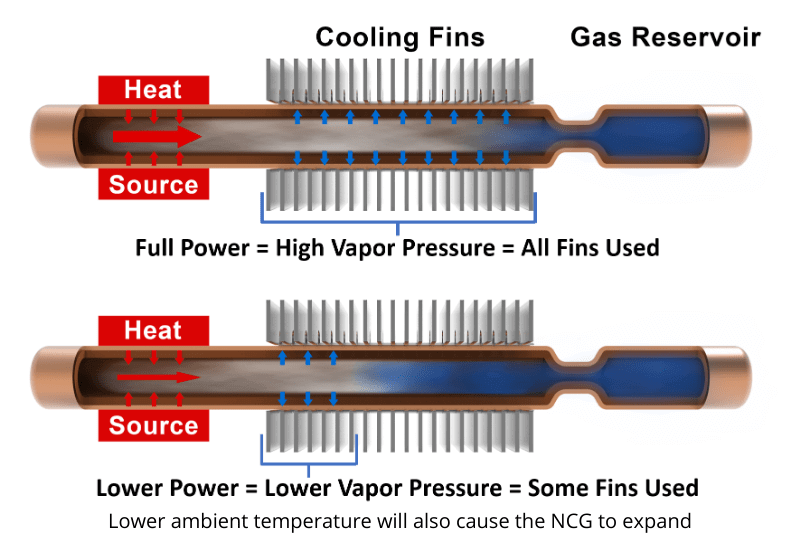
Variable Conductance Heat Pipe (VCHP)
In theory, it’s a remarkably simple execution. Adding a non-condensable gas (NCG), such as nitrogen or argon, to a standard heat pipe turns it into a variable conductance heat pipe. Here’s how it works. The heat pipe(s) and associated condenser (fin stack) must be designed to handle power and ambient temperature at the highest specification rating. In this instance we want the thermal solution to behave just as it would with a regular heat pipe configuration – with the working fluid vapor being able to reach the entire condenser length. Here, at the upper bounds of temperature, working fluid vapor pressure is high enough to push all the NCG to the extreme end of the heat pipe, beyond the condenser region. This allows heat to be expelled into the air using all the condenser fin area. In effect, forcing the heat sink to operate at its lowest thermal resistance.
However, when ambient temperature decreases and/or when the heat source is not at full duty cycle, the NCG expands to fill an increasing portion of the heat pipe vapor space. This prevents the lower pressure working fluid vapor from reaching some or most of the condenser fin area. The result is that the thermal solution now has a higher thermal resistance (less condenser area) so the evaporator stays warmer than it would if a standard heat pipe heat sink had been used.
In practice, these devices are extremely nuanced. As mentioned in the opening of this article, different envelopes, working fluid, and in this case, gas can be used to achieve specific results. Further, the area for the NCG can simply be at the end of a standard heat pipe (no reservoir), it can incorporate a reservoir (as shown above), or it can incorporate a flexible bladder system that expands and contracts.
Thermosiphon | Loop Thermosiphon
As a general rule, a thermosiphon is simply wickless heat pipes – although they sometimes include a grooved ‘wick’ that helps increase the surface area of the internal wall and allow liquid condensate to more easily return to the evaporator. Regardless, they must be used in an orientation that allows gravity to pull the liquid back to the heat source. In other words, the condenser must be above the evaporator.
Relative to standard heat pipes, thermosiphons can carry up to three times the heat transfer capacity (Qmax) for a given diameter pipe enabling a lower volume thermal solution. Further, thermosyphons can transport heat tens of meters as gravity is used for the liquid return. The functional limit for heat pipes working vertically against gravity is on the order of 150mm.
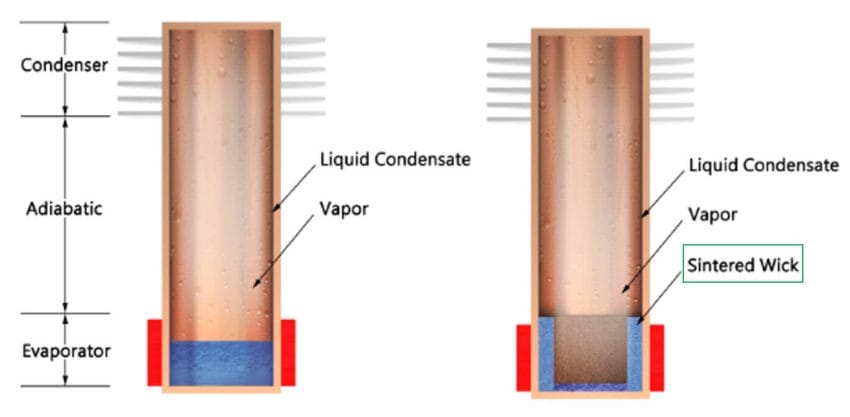
Wickless (L) and Partial Wick (R) Thermosyphons
Adding a sintered wick to the evaporator section lowers thermal resistance and increases the ability to handle higher power densities (shown above). It also allows optimization of the fluid charge, effectively reducing the required liquid. This all but eliminates the possibility of damage caused by freezing. In the figure above, note that the wick is only used at the evaporator section of the thermosyphon.
One of the limits is the interaction of the vapor and liquid condensate traveling in different directions (counter flow). To alleviate this problem, a loop thermosyphon design incorporates a separate vapor path and a liquid return path.
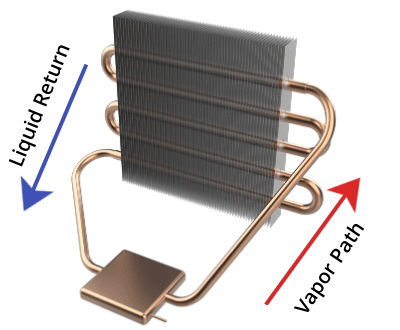
Loop Thermosiphon
Loop thermosyphons do not necessarily need a wick at the evaporator. However, using a wick will lower evaporation resistance and increase the maximum power density. Also, a wick can reduce the possibility of structural damage when using water as working fluid because less water is needed.
For more information on these devices, please check out our Thermosyphon Technology Overview article.
Loop Heat Pipe
A loop heat pipe is similar to a loop thermosyphon but can operate against gravity with the evaporator above the condenser. Its operation depends on the ability of the working fluid to achieve high enough vapor pressure when heated to push the liquid condensate back to the evaporator section of the device. Unfortunately, this can’t usually be done with water as the working fluid. Instead, loop heat pipes use a refrigerant like ammonia where high pressure can be achieved at electronics operating temperatures. Typical operating temperatures for ammonia-based loop heat pipes are between -40 and 70 deg C. Generally, we see this type of device in space-related applications.

Loop Heat Pipe
The image above illustrates a loop heat pipe along with an exploded view of the wick structure inside the rectangular reservoir. With the heat source located on the back, leftward side of the reservoir, the liquid ammonia turns to vapor. Because of the wicked liquid reservoir, vapor is prevented from escaping down the right-side tube and is forced into the horizontal tube to the left. After the condenser section, the tube narrows as the size required for the liquid is quite a bit smaller than required for the vapor. Since there is no wick structure inside the tube itself, the condensate relies on the vapor pressure behind it to push it up the tube where it can be reabsorbed by the wick structure in the reservoir.
Rotating Heat Pipes
Rotating heat pipes rely on rotational force to move the liquid back to the evaporator; two different designs are typical and are both incorporated into the image below. The first uses a wickless copper tube that has a thicker, tapered wall at the condenser end. When vapor turns to liquid condensate, the centrifugal force generated by the rotating pipe pushes the liquid back to the evaporator end. The second requires spiraled grooves (much like a rifle barrel) along the inside walls which are not tapered. For cost reasons, the latter is most often the best choice. Typically, rotating heat pipes are used to remove heat generated in motors and other rotating machinery such as RF rotary joints used in telecommunications.

Rotating Heat Pipe. Two designs depicted in a single image.
Oscillating / Pulsating Heat Pipes
First created in the early 1990’s, oscillating heat pipes are the newest member of the two-phase family. Early versions of this device (not shown) were typically a planar rectangular shape that are comprised of a lower plate into which a series of interconnected pathways are machined, and smooth upper plate that gets bonded to the lower one, air and working fluid. They are so named because of the intermittent pockets of liquid and vapor that pulsate back and forth as they move to cooler areas.
Today, much of the research on oscillating heat pipes involves designs that resemble standard heat pipe assemblies. As seen in the figure below, a wickless closed-loop tube consisting of a series of U-shaped bends is embedded in the evaporator base and condenser fins. Tubes are usually charged with either water or ethanol to between 30-80% of their volume and evacuated. As the heat is applied, vapor bubbles form creating alternating slugs of vapor and water. Further heating expands the vapor slugs, pushing the slugs of water toward the condenser, much in the same way a coffee percolator works.
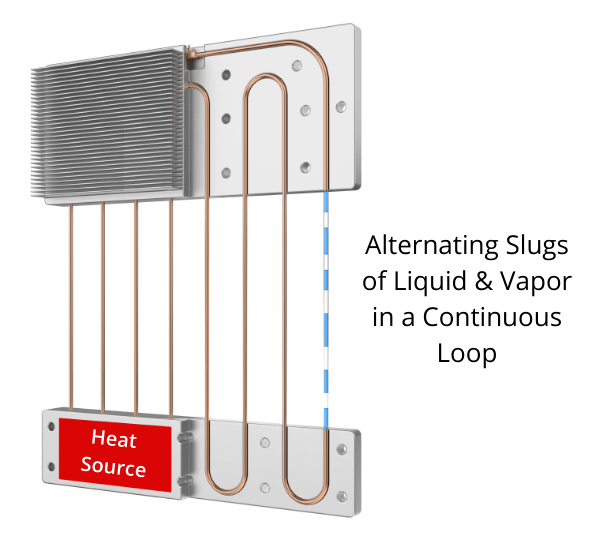
Oscillating Heat Pipe
Here’s a link to an excellent video showing an ANSYS simulation of a closed-loop oscillating heat pipe (from YouTube Channel EasyMechLearn).
Advantages of oscillating heat pipe include the ability to work over longer distances than standard heat pipes as well as very good performance when working against gravity – when the condenser is below the evaporator. Some possible disadvantages include start-up issues and operating performance at low temperatures or low power. Further, heat-carrying capacity (Qmax) and power density are lower than for other two-phase devices because the inner diameter of oscillating heat pipes is determined by the viscosity and surface tension of the working fluid so the inner tube diameter is on the smaller side.
Celsia is a custom heat sink manufacturer using vapor chamber and heat pipe technology. We specialize in: heat sink design, heat sink proto, heat sink manufacturing, heat pipes, vapor chambers, custom heat pipe wick materials.

